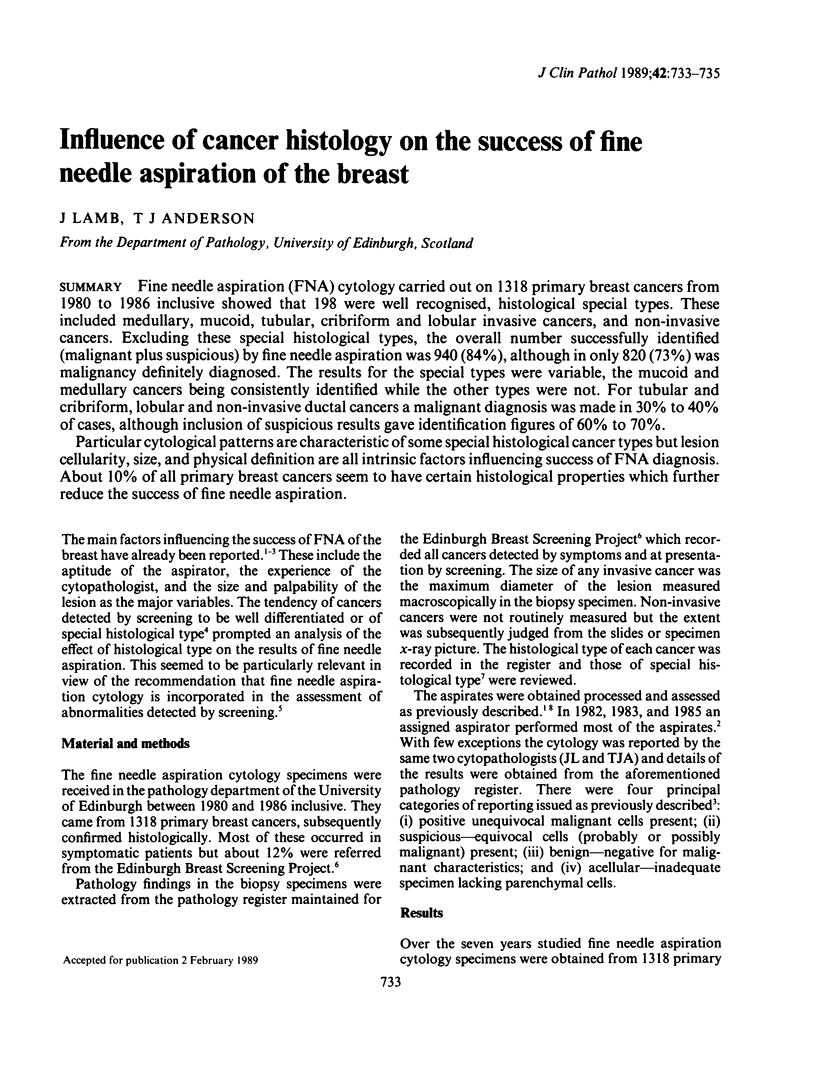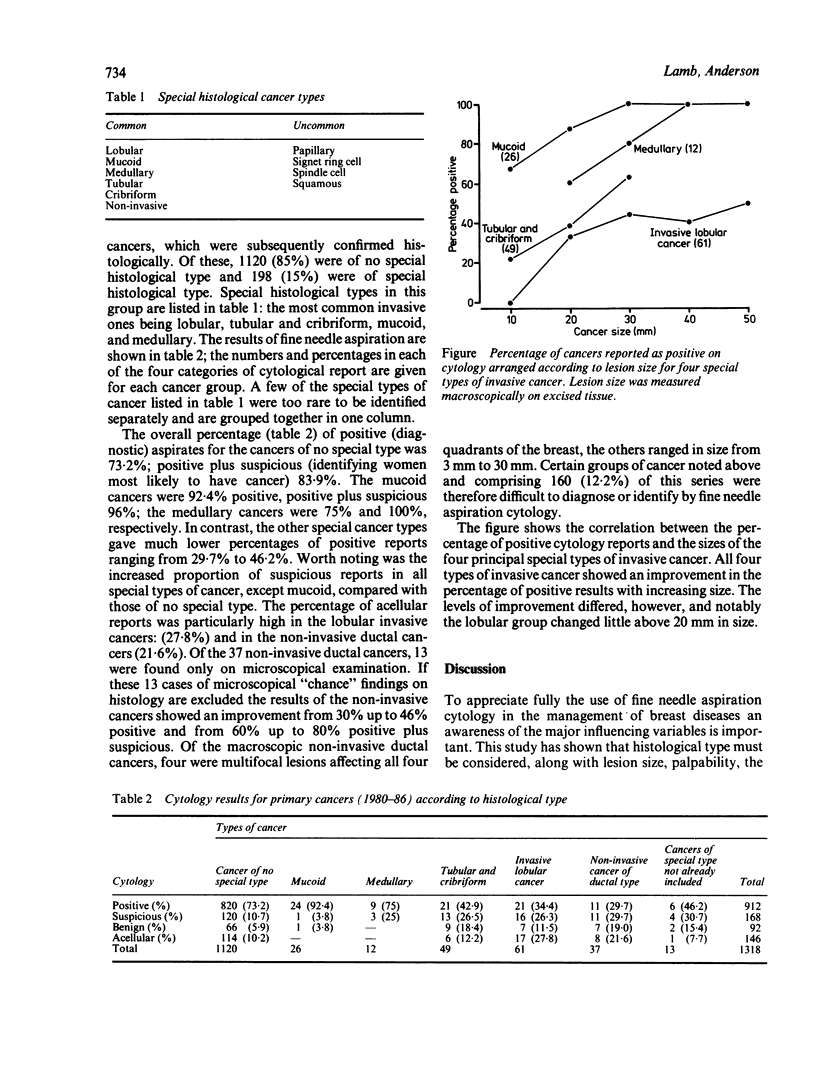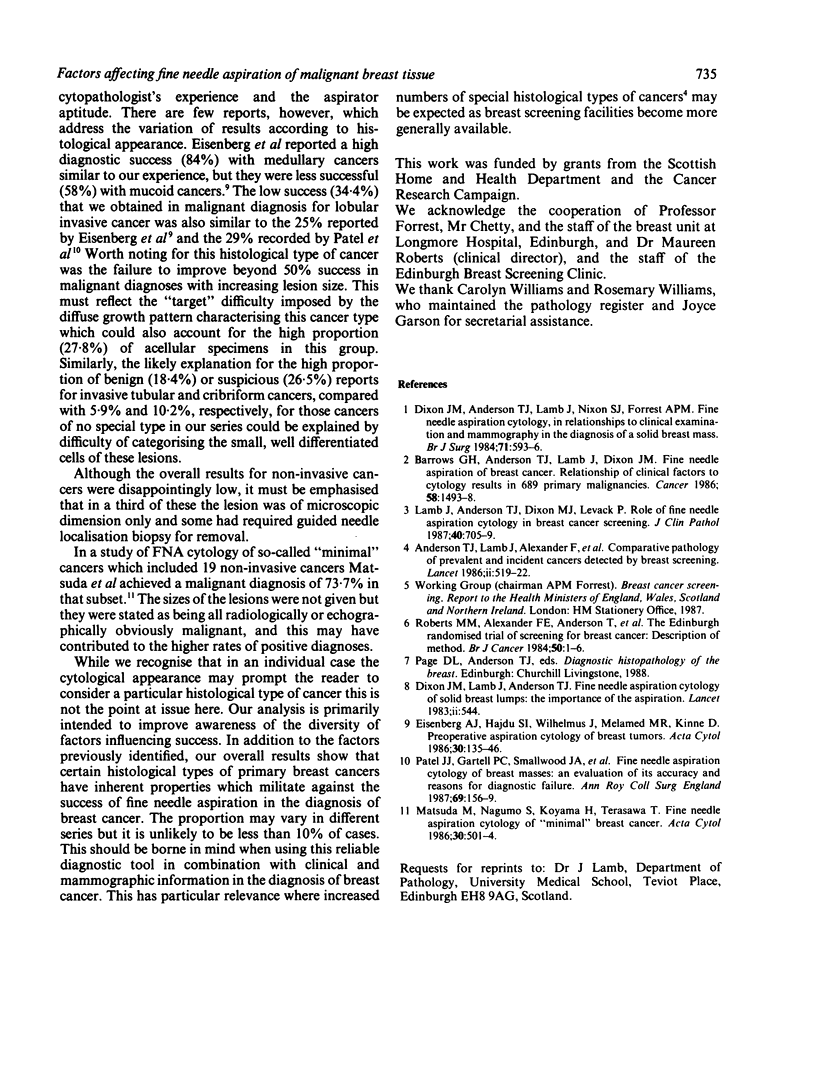Abstract
Fine needle aspiration (FNA) cytology carried out on 1318 primary breast cancers from 1980 to 1986 inclusive showed that 198 were well recognised, histological special types. These included medullary, mucoid, tubular, cribriform and lobular invasive cancers, and non-invasive cancers. Excluding these special histological types, the overall number successfully identified (malignant plus suspicious) by fine needle aspiration was 940 (84%), although in only 820 (73%) was malignancy definitely diagnosed. The results for the special types were variable, the mucoid and medullary cancers being consistently identified while the other types were not. For tubular and cribriform, lobular and non-invasive ductal cancers a malignant diagnosis was made in 30% to 40% of cases, although inclusion of suspicious results gave identification figures of 60% to 70%. Particular cytological patterns are characteristic of some special histological cancer types but lesion cellularity, size, and physical definition are all intrinsic factors influencing success of FNA diagnosis. About 10% of all primary breast cancers seem to have certain histological properties which further reduce the success of fine needle aspiration.
Full text
PDF


Selected References
These references are in PubMed. This may not be the complete list of references from this article.
- Anderson T. J., Lamb J., Alexander F., Lutz W., Chetty U., Forrest A. P., Kirkpatrick A., Muir B., Roberts M. M., Huggins A. Comparative pathology of prevalent and incident cancers detected by breast screening. Edinburgh Breast Screening Project. Lancet. 1986 Mar 8;1(8480):519–523. doi: 10.1016/s0140-6736(86)90882-2. [DOI] [PubMed] [Google Scholar]
- Barrows G. H., Anderson T. J., Lamb J. L., Dixon J. M. Fine-needle aspiration of breast cancer. Relationship of clinical factors to cytology results in 689 primary malignancies. Cancer. 1986 Oct 1;58(7):1493–1498. doi: 10.1002/1097-0142(19861001)58:7<1493::aid-cncr2820580720>3.0.co;2-f. [DOI] [PubMed] [Google Scholar]
- Dixon J. M., Anderson T. J., Lamb J., Nixon S. J., Forrest A. P. Fine needle aspiration cytology, in relationships to clinical examination and mammography in the diagnosis of a solid breast mass. Br J Surg. 1984 Aug;71(8):593–596. doi: 10.1002/bjs.1800710809. [DOI] [PubMed] [Google Scholar]
- Eisenberg A. J., Hajdu S. I., Wilhelmus J., Melamed M. R., Kinne D. Preoperative aspiration cytology of breast tumors. Acta Cytol. 1986 Mar-Apr;30(2):135–146. [PubMed] [Google Scholar]
- Lamb J., Anderson T. J., Dixon M. J., Levack P. A. Role of fine needle aspiration cytology in breast cancer screening. J Clin Pathol. 1987 Jul;40(7):705–709. doi: 10.1136/jcp.40.7.705. [DOI] [PMC free article] [PubMed] [Google Scholar]
- Matsuda M., Nagumo S., Koyama H., Terasawa T. Fine needle aspiration cytology of "minimal" breast cancer. Acta Cytol. 1986 Sep-Oct;30(5):501–504. [PubMed] [Google Scholar]
- Patel J. J., Gartell P. C., Smallwood J. A., Herbert A., Royle G., Buchanan R., Taylor I. Fine needle aspiration cytology of breast masses: an evaluation of its accuracy and reasons for diagnostic failure. Ann R Coll Surg Engl. 1987 Jul;69(4):156–159. [PMC free article] [PubMed] [Google Scholar]
- Roberts M. M., Alexander F. E., Anderson T. J., Forrest A. P., Hepburn W., Huggins A., Kirkpatrick A. E., Lamb J., Lutz W., Muir B. B. The Edinburgh randomised trial of screening for breast cancer: description of method. Br J Cancer. 1984 Jul;50(1):1–6. doi: 10.1038/bjc.1984.132. [DOI] [PMC free article] [PubMed] [Google Scholar]


